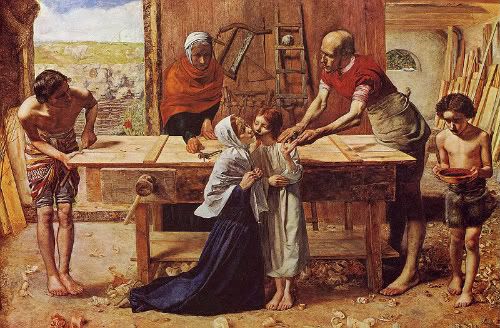
Christ in the House of His Parents was first exhibited by John Everett Millais at the Royal Academy in 1850 when he was was just 20 years old. The work was accompanied by a quote from Zechariah 13:6 "And who shall say unto him, What are these wounds in thine hands? Then he shall answer, Those with which I was wounded in the house of my friends."
The symbolism in this painting is particularly rich. Furthermore, because the story of Christ is well-known by most viewers, it's quite easy to analyse the painting. It is evident a young Jesus has somehow injured his hand after trying to remove a nail from the door on the work table with the pliers (some of his blood is visible on the door). The blood from the wound in his hand has also trickled onto his foot, foreshadowing the crucifixion. We can see his cousin John (the Baptist), on the right bringing him water to wash his wound--prefiguring, of course, Christ's baptism. Behind Christ's head at the top of the ladder in the background you can also see a dove, symbolising the Holy Spirit. Immediately above his head are Joseph's carpenter tools, suggesting the "crown of thorns" and representing the tools of his crucifixion.
Millais has placed an unfinished basket in the left foreground, signifying the work the remains to be done in Jesus' life. In the right background you can see a candle burning in the window, representing time. I also loved the way that Millais set up a cross pattern behind the young Jesus. By placing Christ in the centre of the painting, the worktable forms a cross with his body. Then, above his head you can see a cross formed out of the crack in the wall and the end of the saw. Can you see it?
The painting elicited a strong reaction among critics. Charles Dickens was deeply offended by the stark realism of the work, which he considered ugly and blasphemous (Blackwood's Magazine reacted similarly). Moreover, with its emphasis on child baptism and the necessary separation between the church (Christ and his family) and the laity (persons who are not clergy--depicted in the painting as the penned sheep). Nevertheless, despite whatever theological objections Ruskin had to the work, he continued to defend Millais against the critics, saying "Millais first showed me the beauty of extreme minuteness and precision."
Works consulted: Robert Hewison. Ruskin, Turner and the Pre-Raphaelites. London: Tate Gallery Printing, 2000, 30.
Tuesday, July 22, 2008
Christ in the House of His Parents, Sir John Everett Millais
Posted by
Margaret
at
9:45 AM
![]()
![]()
Labels: millais, pre-raphaelites
Subscribe to:
Post Comments (Atom)


3 comments:
The last 2 posts (I've caught up) are fascinating. It's so good to match the painting with biography.
The symbolism in the lastest post reminded me of a TV joke -a man said he went into an art gallery with some one raised as an agnostic. "It was so boring- they just went around asking "Who's that?" and any Christian could tell who they were, by what they had with them." I think having symbolism tells so much more than the surface story. Thanks for going through the painting. Very interesting.
Thank you, Melanie! It would be terribly sad to grow up without awareness of Christian symbolism. It is so prevalent in films and art that it would be a serious disadvantage to not be familiar with it!
The same is true for Classical motifs from mythology. I'm forever wishing I had better knowledge of the Classics!
absolutely beautiful and breathtaking!!
Post a Comment